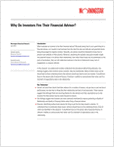In July 2013 Prudential Group Insurance partnered with market research firm Greenwald & Associates to survey more than 600 larger employers that offered either short- or long-term disability benefits, or both. The companies ranged in size from 100 to over 10,000 employees. The goal was to gain a greater understanding of how employers are approaching employee disability challenges with:
- Benefit solutions;
- Partners and services;
- The type of disability benefits employers currently offer their employees;
- The types of vendors they use; and
- What services affect their carrier selection decisions.
The result was a better view of the carrier selection criteria larger employers have adopted.
Buying Behavior
The survey identified several distinct clusters among respondents based on their criteria for selecting a disability carrier. The three most significant clusters, which Prudential labels as “Already Theres,” “Aspirers” and “Laissez-Faires,” differ considerably from each other as the following highlights illustrate.
| Cluster |
Key Features |
| Already Theres |
|
| Aspirers |
|
| Laissez-Faires |
|
Business Opportunities
Many employers know that a robust benefits package can help attract and retain valued employees, which is critical for managing productivity and maximizing human capital. At the same time, though, companies must control benefit costs. Recognizing a company’s cluster profile can provide insight into its goals and likely buying behavior and add value to a consultative relationship. Additionally, the information can indicate possible approaches to meet both the benefits-quality and cost-control goals that companies attempt to balance.
The survey results highlighted that employers often experience a gap between their absence management and RTW goals and their actual capabilities in those areas. Producers and consultants can help groups close those gaps.








 May 07, 2014 at 06:09 AM
May 07, 2014 at 06:09 AM










